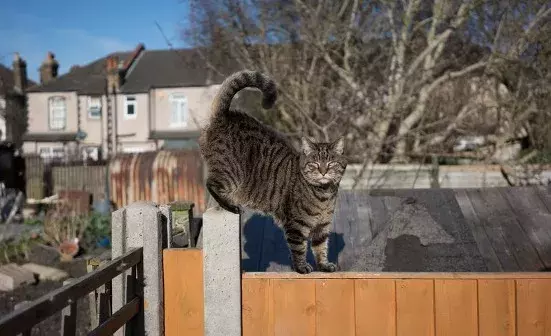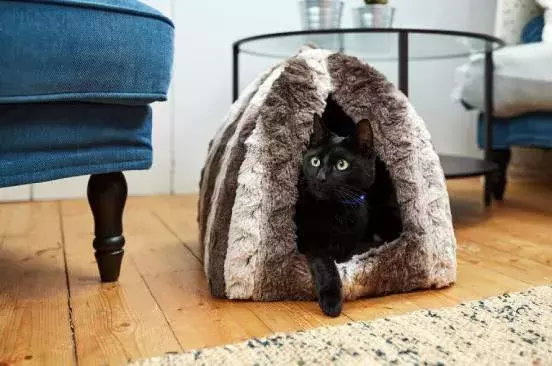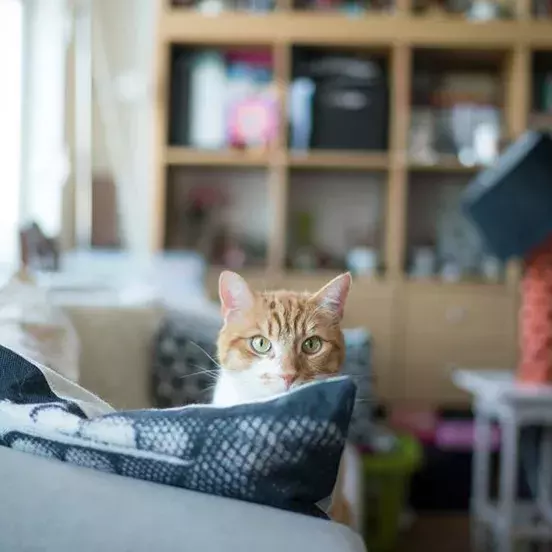This guidance will help you make your home cat-friendly and enriching for your cat.
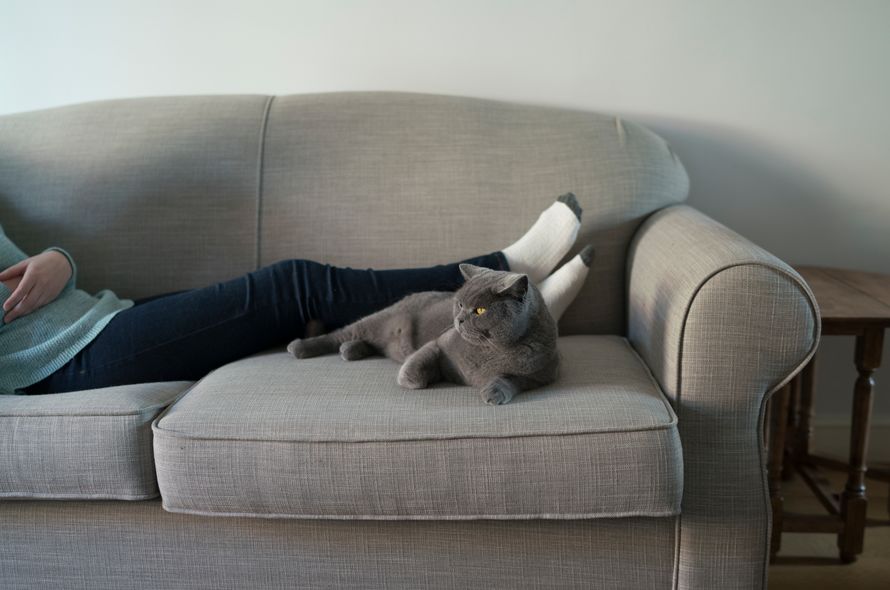
WHY IS THIS IMPORTANT?
As we know, a cat is very different to a dog, and has a range of specific needs that reflect this. Unlike domestic dogs, cats are much more closely related to their recent wild, asocial ancestors. This means that whilst many cats are very confident, friendly and seemingly unfazed by our often busy and unpredictable lifestyles, others may sometimes struggle to live in an environment so different to that of their wild relatives.
However, by following the advice provided below, your cat has the best chance of having a happy and enriched life with you.
WHAT DO WE MEAN BY ENRICHING?
Every cat should be able to thrive in their new home. Therefore, whilst it’s very important that each cat is kept in good physical health, it's also important to ensure each cat also feels safe and secure, and in addition has plenty of opportunity to experience pleasure and positive emotions.
All this can be achieved by providing your cat with a stable and predictable environment, as well as various sources of enrichment or ‘entertainment’.
WHERE SHOULD YOU BEGIN?
A good way to understand the fundamental needs of cats and their order of importance is to think of them within a pyramid – the needs at the bottom will be of primary importance to your cat, but once these have been sufficiently met, the next level of the pyramid will become the priority, and so on.
Your cat’s most primary need is to be free from pain and disease, to have access to food and water, and to be physically comfortable. The next need is for them to feel safe, to be able to retreat and hide from challenging or unpleasant situations, and to have safe access to all their important resources (i.e. the things they need).
After these needs are sufficiently taken care of, the next priority is for them to have a predictable, relatively calm, and stable environment. If they feel all these needs are already adequately provided for, they will then prioritise exploration and various forms of environmental and social interaction (depending on their temperament – they will value social interaction to a greater or lesser degree).
BASIC HIERARCHY OF NEEDS FOR CATS

The needs at the top of the pyramid (such as environmental stimulation) are unlikely to be a priority for your cat if they don’t first feel safe or have predictable access to their resources, so efforts should be made to ensure these needs (i.e. needs 1-3) are met before trying to encourage them to play or interact socially with people (i.e. need 4), because this could be too overwhelming for them at this point, particularly if they has only recently been introduced to your household.
Depending on the temperament of your cat, their current physical and emotional state, as well as the environment they are in, they may need some extra support for some of these needs to be met. For example, a very timid cat may need a much quieter and more predictable environment for need 3 of the pyramid to be met than a bold, confident cat, who in turn might need much more environmental stimulation for their need 4 to be satisfied.
NEEDS 1-2: PHYSICAL HEALTH, PERSONAL SAFETY AND ACCESS TO RESOURCES
How to take care of your cat’s basic health, provide them with all their basic resources, and help them to feel safe and stress free is covered in our advice on reducing your cat's stress.
NEED 3: PREDICTABILITY AND STABILITY
The following advice will help you to be able to provide a stable, calm and predictable environment for your cat. What’s most important is that your cat feels they have choice and control over various aspects of their life, and the more that they can predict when both good and not so good things are going to happen (see examples below), the happier, more settled and less anxious and frustrated they are likely to feel.
Keeping to a general routine will allow your cat to feel more in control of their surroundings. For example:
- Feeding them at the same times each day.
- Keeping their main resources (e.g. food, water, litter trays and beds, hiding places) in the same quiet and undisturbed locations. If any resources have to be moved (i.e. due to decorating, or the arrival of a baby), do this gradually, one at a time, rather than changing everything at once.
- Being consistent in the way they are handled and interacted with.
- Being consistent in terms of what rooms of the house they can and can’t have access to. This will be easier for them to get used to than if they are only sometimes allowed in certain areas (such as the bedroom), which might cause their frustration when they are suddenly shut out.
- If they are particularly sensitive to noise and disturbance, try keeping cleaning to predictable times – this way they can anticipate when the disturbance is going to happen and take themselves off somewhere quieter if necessary.
In addition, the following will also help:
- Making sure they always have access to a hiding place or quiet area of the house, particularly when it is noisier or busier (for example when visitors come to the house, when the vacuum cleaner is on, when loud music is being played, furniture is being moved, or the house is being decorated).
- Cats deposit special pheromones via skin glands located around their face and other areas of their body (such as their tail and between their paws), and they will rub these glands on furniture and other objects around the house (you may have seen your cat doing this, or you might have noticed the marks they leave behind afterwards – especially on white surfaces). These pheromones are thought to make the environment feel more familiar and reassuring to your cat, and therefore you should avoid cleaning these marks away, at least too often.
- If your cat has specific areas in the house where they sleep, avoid washing all their blankets/bed cushions at once. This will help to maintain the presence of their smell within the house and again make it seem more familiar to them.
- If you have a cat flap, make sure no cats from the neighbourhood can enter the house – the best way to do this is to install a microchip operated cat flap.
- Scratching is a natural behaviour that cats perform to keep their claws in good condition, but your cat may also want to scratch to make the environment smell (by using the scent glands located in between the pads on their paws to deposit scent) and look (via the visual marks the scratches leave) more secure and familiar. Providing them with specific objects to scratch on is therefore a good idea.
CHOICE AND CONTROL
It’s also a very good idea to provide your cat with as much choice as possible, for example:
- Providing their with multiples of the following, in different places around the house; beds, hiding spaces (e.g. cardboard boxes, cat igloos, areas under beds or other furniture) and places to get up high (e.g. cat trees, shelves and window ledges), litter trays and sources of food and water. Because cats have exceptional hearing and sense of smell, there may be noises and smells in parts of the house that we can’t detect, but that are off putting to them (for example the chemicals in cleaning products or high frequency noises emitted by household equipment such as washing machines and televisions etc.). Therefore, providing them with more than one place to sleep, toilet, drink, eat, rest etc. will help them to avoid anything they might find unpleasant in their environment, whilst still allowing them to access the things they need.
- Allowing them to decide whether they want to interact with people or not, and if so how long for.
- Allowing them to take themselves away to be in a quiet room of the house undisturbed if they want to.
- Allowing them to come and go within the house and to have unrestricted access to a garden or outside space.
NEED 4 - ENVIRONMENTAL AND SOCIAL STIMULATION:
The following advice will help you to be able to provide your cat with positive environmental and social stimulation. However, each cat is an individual and may have their own specific preferences for the types of things they do or don’t enjoy. Therefore, an amount of trial and error, combined with frequent observations of your cat are important to identify their preferences.
OUTDOOR ENRICHMENT
Access to a safe, stimulating outdoor environment
Most cats are highly motivated to spend a large proportion of their day exploring and seeking out interesting sights, smells, sounds, textures and tastes within their surroundings. Your cat may get a lot of pleasure from performing these activities, which will help to keep them both mentally stimulated and physically fit and active. One of the easiest ways to achieve this is to provide their with a positively stimulating outdoor area.
For further information about how to provide this please see our advice on how to make your garden or outside space cat-friendly and enriching for your cat.
INDOOR ENRICHMENT
Feeding
Puzzle feeders can make feeding times more of a challenge, which is a great source of mental stimulation for your cat. They will also help to keep your cat physically active, stop their from eating too fast, and encourage their to perform parts of their natural predatory sequence (for example seeking out the food, using their paws and mouth to manipulate the feeder).
Puzzle feeders are generally made of plastic for ease of cleaning, and come in a range of different shapes and sizes. Some are ball shaped and roll around as the cat paws at them, whilst others are stationary and require the cat to push, scoop or lick at them in order to get the food out.
Puzzle feeders are designed to be used with either your cat’s treats, or their normal kibble or wet food. Some cats may prefer stationary feeders whilst other cats may prefer ones that move when pushed or touched. Some cats may like a combination of both types. If your cat is very food motivated and can use puzzle feeders easily, they may benefit from being fed all of their food portions (i.e. both wet and dry) in the feeders. Wet food is usually easier to use with stationary feeders rather than moveable ones. To keep the puzzle feeders interesting for your cat, we suggest using a couple and changing them each time you feed them.
Play
Play is another great source of mental stimulation, as well providing physical exercise for your cat. Play may also encourage them to direct their predatory behaviours towards ‘safe’ objects rather than your hands or feet, or live prey.
Some cats may prefer to play with people, other cats with toys by themselves, and some may enjoy a combination of both. When playing with your cat, long fishing rod type toys with feathers, bits of ribbon, or prey-sized furry objects on the end are some of the best kinds. The way the object is attached to the end of the string can be moved around can be quite stimulating for your cat, but the good thing is that it is also far enough away from your hands so they don’t get in the way of your cat’s teeth or claws whilst they are playing.
Toys that mimic the size, shape and texture of prey (e.g. furry mouse sized toys or those made of feathers) can be particularly good to encourage interest from your cat, especially if they are filled with catnip. They may also enjoy playing with these prey-like toys on their own. However, catnip can strongly stimulate some cats, so we advise that you don’t try to handle or touch your cat whilst they're experiencing the effects of catnip.
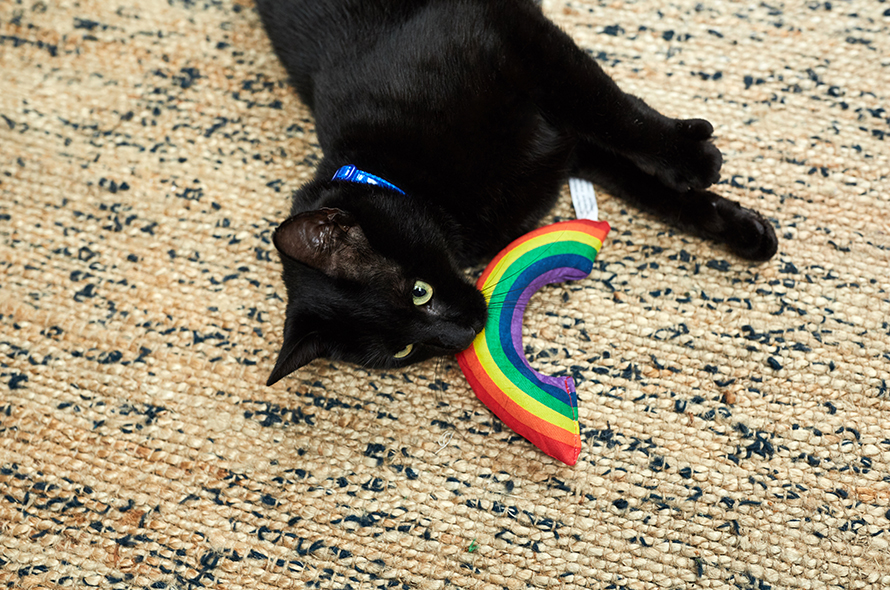
To keep toys novel and interesting, it’s good to store some of them away and only bring them out during play sessions (especially the fishing rod types). Other toys can be left out for your cat to play with by themselves, but these should be changed regularly to keep them exciting for your cat. Avoid leaving string/fishing rod toys out as there's a chance your cat could get tangled up in them.
Cats enjoy both being up high and having a good ‘vantage point’, as well as hiding and being concealed. Provide your cat with an environment that contains lots of elevated places they can climb up or jump on, as well as quiet places they can hide (e.g. a mixture of cat trees, cat tunnels and shelving, combined with cat ‘igloos’ and cardboard boxes.
Cats also enjoy exploring and seeking out new sights, smells, sounds, textures and tastes. You can help to stimulate your cat’s senses in this way by providing the following (for outdoor examples see our advice on how to make your garden or outside space cat-friendly and enriching for your cat).
Examples of indoor things to stimulate your cat’s senses
- A large cardboard box with leaves, food or natural feathers scattered inside.
- A large cat tunnel again with leaves, food, or feathers scattered in it.
- A range of suitable indoor plants, especially catnip and cat grass. These can be easily grown in small pots and placed around the house for your cat to sniff and chew on.
- Please see guidance on poisonous plants to avoid.
- A range of different materials and textures to scratch on e.g. sisal posts (see photo above), corrugated cardboard scratching blocks, logs or tree stumps – these can be sprinkled with herbs such as catnip or valerian to make them extra appealing.
- As well as using puzzle feeders, you could also try ‘scatter feeding’ with your cat by placing small amounts of their dry kibble in different places around the house for their to search for (but make sure they first feels settled and comfortable in your home before doing this).
Positive, appropriate interaction with people
This is another potentially great source of positive stimulation for your cat.
